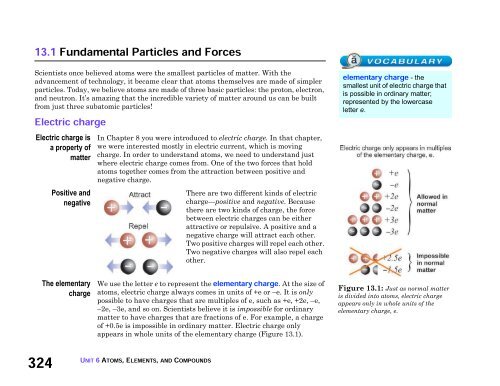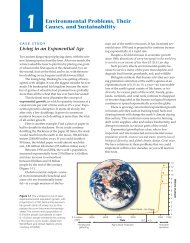Atoms, Elements, and Compounds - Spokane Public Schools
Atoms, Elements, and Compounds - Spokane Public Schools
Atoms, Elements, and Compounds - Spokane Public Schools
You also want an ePaper? Increase the reach of your titles
YUMPU automatically turns print PDFs into web optimized ePapers that Google loves.
13.1Fundamental Particles <strong>and</strong> Forces<br />
Scientists once believed atoms were the smallest particles of matter. With the<br />
advancement of technology, it became clear that atoms themselves are made of simpler<br />
particles. Today, we believe atoms are made of three basic particles: the proton, electron,<br />
<strong>and</strong> neutron. It’s amazing that the incredible variety of matter around us can be built<br />
from just three subatomic particles!<br />
Electric charge<br />
elementary charge - the<br />
smallest unit of electric charge that<br />
is possible in ordinary matter;<br />
represented by the lowercase<br />
letter e.<br />
Electric charge is<br />
a property of<br />
matter<br />
Positive <strong>and</strong><br />
negative<br />
In Chapter 8 you were introduced to electric charge. In that chapter,<br />
we were interested mostly in electric current, which is moving<br />
charge. In order to underst<strong>and</strong> atoms, we need to underst<strong>and</strong> just<br />
where electric charge comes from. One of the two forces that hold<br />
atoms together comes from the attraction between positive <strong>and</strong><br />
negative charge.<br />
There are two different kinds of electric<br />
charge—positive <strong>and</strong> negative. Because<br />
there are two kinds of charge, the force<br />
between electric charges can be either<br />
attractive or repulsive. A positive <strong>and</strong> a<br />
negative charge will attract each other.<br />
Two positive charges will repel each other.<br />
Two negative charges will also repel each<br />
other.<br />
The elementary<br />
charge<br />
We use the letter e to represent the elementary charge. At the size of<br />
atoms, electric charge always comes in units of +e or –e. It is only<br />
possible to have charges that are multiples of e, such as +e, +2e, –e,<br />
–2e, –3e, <strong>and</strong> so on. Scientists believe it is impossible for ordinary<br />
matter to have charges that are fractions of e. For example, a charge<br />
of +0.5e is impossible in ordinary matter. Electric charge only<br />
appears in whole units of the elementary charge (Figure 13.1).<br />
Figure 13.1: Just as normal matter<br />
is divided into atoms, electric charge<br />
appears only in whole units of the<br />
elementary charge, e.<br />
324 UNIT 6 ATOMS, ELEMENTS,AND COMPOUNDS

















